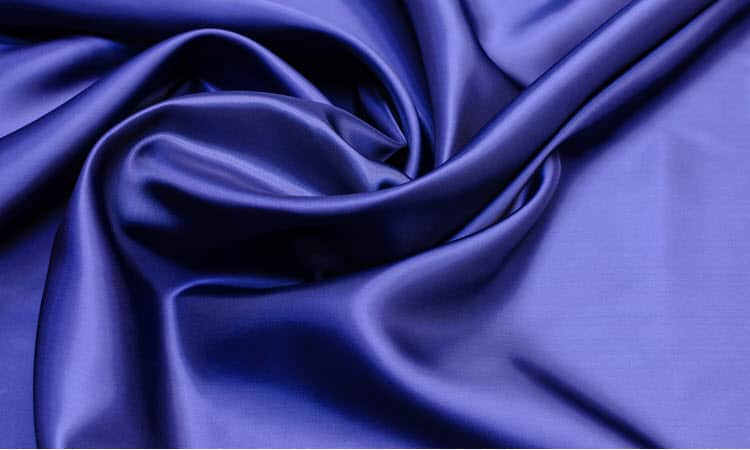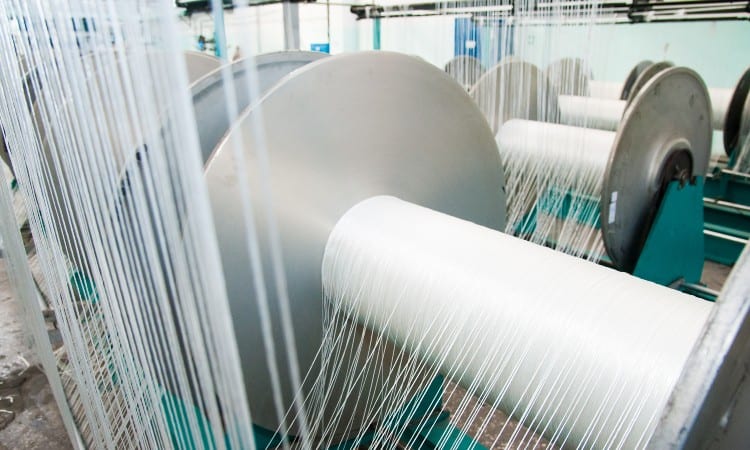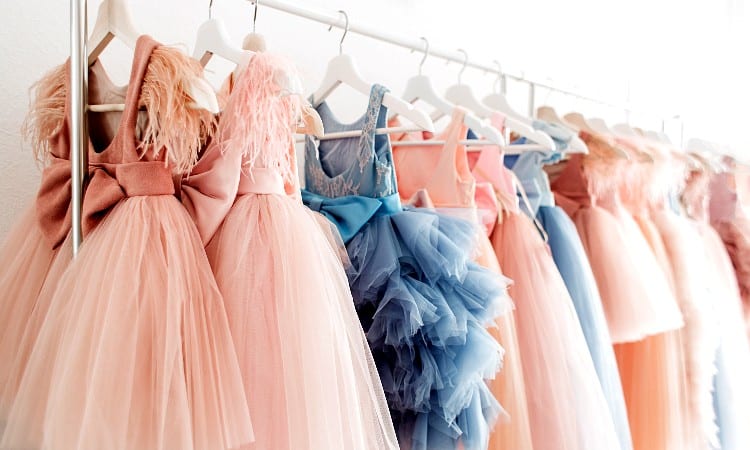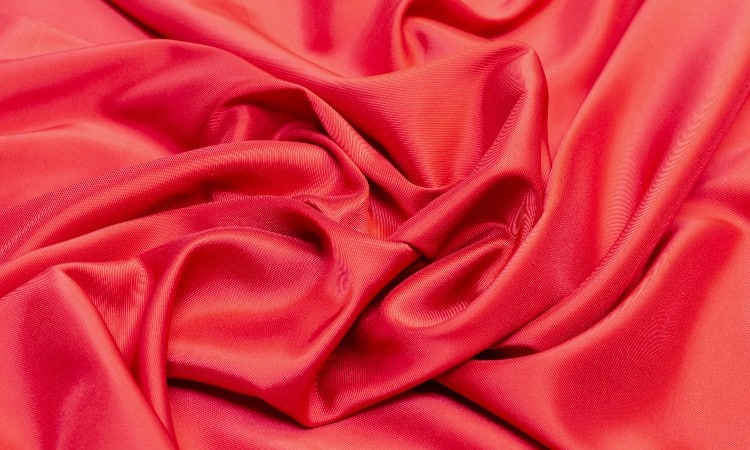When I was in the fabric store, I came across some acetate fabric. Smooth and silky to the touch, it felt soft and delicate. So much so that I thought it was some kind of silk. But it wasn’t. How can acetate be so silk-like and yet not be silk? What is acetate fabric?
Acetate fabric is a semi-synthetic material derived from wood pulp and acetic acid. As a member of the rayon family, acetate is a silk substitute, and can be used for drapes, evening attire, and bridal wear. Fabric made from 100% acetate is delicate. To counteract that, it is blended with other fibers like cotton to create a more durable textile.
In this article, you’ll learn all about acetate fabric, from the pros and cons of the material to the best uses. Read on to find out if acetate fabric can be used in your next project.

Quick Navigation
What Is Acetate Fabric?
Acetate fabric is a semi-synthetic fiber. It’s made from the cellulose of wood pulp which has been treated with various acids. These include acetic acid, acetic anhydride, and sulfuric acid.
With a part natural, part synthetic base, acetate fabric has much in common with viscose. Like viscose, acetate is a member of the rayon family, along with modal, lyocell, and cupro.
With a similar luxurious feel to silk, acetate fabric is often used as a cheap alternative. You’ll often find it in bridal wear, prom dresses, and undergarments.
Acetate has been around since the mid-19th century. Although, back then, it wasn’t intended to be used as an apparel fabric. Early examples of acetate were highly flammable and a challenge to work with. So much so that it wasn’t until the early 20th century that an important commercial breakthrough was made.
That breakthrough would be influential in acetate’s success as a fabric, not for clothing but for planes. It was found that exposing early acetate to hydrolysis made it soluble in organic solvents like acetone. The resulting substance was known as cellulose diacetate.
Back in the days of World War 1, plane wings were made of fabric. The newly developed cellulose diacetate was used as a fire-retardant varnish for the wings. Developed by two pioneering Chemists, Henri and Camille Dreyfus, the soluble acetate was in high demand.
However, as the war ended, the need for cellulose diacetate declined. So the brothers, Henri and Camille, changed their focus. Instead of making varnish, they started making diacetate fibers.
In the early 1920s, their company, British Celanese Ltd., began the commercial production of a revolutionary fabric fiber known under the trade name Celanese. Later in that same decade, DuPont introduced a new fabric product to the US, known as acetate fabric.
Further improvements to the initial formulae saw the introduction of triacetate, a fabric that was easier to wash, had better shape retention, and shrink resistance. Depending on where you are, you’ll know triacetate as either Tricel or Arnel.
Acetate is less popular for apparel these days and tends to be used more as a lining fabric. It has been replaced by polyester, which is cheaper and more durable. 100% acetate is particularly delicate and must be either dry cleaned or hand washed, depending on the garment’s care instructions.
To make the fabric more durable, it is more often blended with other fibers. Cotton, silk, wool, and polyester can all be added to acetate to give it extra strength. This also makes the fabric more suitable for busy modern lifestyles. Blended acetate is more of an easy-care material that can be machine washed.
How Is Acetate Fabric Made?

Acetate fabric is made by treating wood pulp with acetic acid, sulfuric acid, acetone, and acetic anhydride. A little-known fact about acetate is that it can also be made using cellulose from the cotton plant.
The cellulose from wood or cotton is left to soak in acetic acid at a controlled temperature. After a while, acetic anhydride and sulfuric acid are added to the mix, producing a thick, clear solution known as cellulose acetate.
This solution is fed through a device known as a spinneret which forms filaments or fibers. These fibers are solidified and wound onto bobbins as yarn. The bobbins are sent to textile manufacturers to be woven or knit into fabric.
Because acetate is partially synthetic, it can be difficult to dye. The colors are added during the production process. Special finishes are also added as the yarn is turned into a material.
What Are the Uses of Acetate Fabric?

Acetate fabric is a surprisingly versatile material. Depending on the fiber content of the acetate, and the weave of the textile, it can be used for all sorts of products and projects.
As acetate fabric is known for having excellent drape and a silk-like feel, it is often used for bridal wear and prom dresses. It gives the same look as silk without the high price tag. Better still, as it’s hard to tell the difference between silk and acetate, your wedding party or prom date will think you’re wearing silk. To be honest, as it’s so comfortable and slinky, so will you!
Acetate fabric isn’t just for posh frocks, though. You can celebrate your graduation in an acetate gown and matching cap. Your loved ones can watch you collect your diploma wearing a suit made from acetate. They can even add an acetate hat and tie to complete the ensemble.
It’s not just the external part of the suit that can be made from acetate fabric. Pant or skirt suits have lining fabric inside the skirt, the pants, or the jacket, especially in expensive suits or if the outer fabric is scratchy. The material used as a lining fabric has to be soft, lightweight, and comfortable next to the skin. Acetate ticks all the right boxes and is a popular choice for lining garments.
Sportswear, underwear, sweaters, and coats can all be made using acetate fabric. Regardless of whether it’s 100% acetate or a blend with other fibers, you’ll find some form of acetate in lots of different clothing items.
You’ll also find acetate in your living room and bedroom. Acetate fibers are used in furniture, drapes, and soft furnishings. From the carpet on your floor to the valance above your window, your home décor is another area where acetate excels.
Next time it rains and you need to take an umbrella, check the label inside it. That water-resistant fabric above your head might contain a large dollop of acetate.
Even on sunny days when you wear your favorite shades, acetate isn’t far away. Acetate isn’t just a fiber that can make a soft fabric. It can also be hardened to form plastic. In this solid state, it can be used for the frames of glasses, costume jewelry, and plastic imitations of things like tortoiseshell ornaments.
One of the lesser-known uses of acetate is in an industry that is slowly declining in popularity. Acetate is used to make cigarette filters and helps reduce the amount of nicotine and tar inhaled by the smoker.
On a lighter note, you can also find acetate in cheerfully colored ribbons and bows. Whether you’re wrapping a birthday present or decorating a room for a party, acetate has got you covered.
Acetate Fabric: Characteristics

Acetate fabric is a semi-synthetic material that has the characteristics of natural and artificial fibers. Both the good ones and the bad. Because of this, it can be biodegradable like cotton yet mold resistant like nylon. But it isn’t breathable like silk and can make you feel sweaty like polyester. Let’s take a look at some of the acetate’s main properties.
Breathability
To be classed as a breathable fabric, a material has to have the ability to regulate your body temperature. Cotton, wool, and silk are all good examples of breathable textiles. They can help you stay cool or warm, depending on how much moisture and air they can keep away from your skin.
As acetate is a part-natural, part-synthetic fiber, you would expect it to be somewhat breathable. Unfortunately, this is one area where its artificial side is more dominant.
Although acetate can keep you cool in the summer, you do have to watch the temperature. It’s a quick-drying fabric and like most members of the rayon family, it doesn’t absorb water. It allows moisture to evaporate.
The warmer you get, the more you sweat. As the sweat hits your acetate clothing, the moisture will evaporate and the fabric will dry quickly.
However, acetate has a saturation point. Too much sweat will leave the fabric unable to dry fast enough. Moisture will build up and get trapped next to your skin, making you and your clothing feel hot and soggy.
Durability
Acetate used in apparel isn’t particularly durable. 100% acetate is incredibly delicate and can’t withstand regular or daily use. Not only does it snag and tear easily, but it also tends to pull away at the seam lines causing the fabric to fray.
It can be blended with other fibers like polyester to improve durability, but acetate is best reserved for garments that are used infrequently. This is why it’s perfect for bridal wear or prom dresses. These are low-use items that are unlikely to be worn more than once.
The fabric doesn’t take well to washing and a spin in a dryer can prove fatal. Color fades quickly and the material is prone to wrinkles. Acetate is not the ideal fabric for a wash and wear work garment, regardless of whether you work in an office or on a building site. It just can’t take the pace.
Acetate does have a couple of durable elements. Moths hate it and it’s mold resistant. It does not shrink and is immune to pilling.
Look and Feel
Lightweight with a smooth, soft, and elegant feel, acetate fabric looks and feels like silk. In fact, it is an affordable silk substitute. It’s so close to silk it can be difficult to tell an acetate garment from a silk one.
Although it isn’t one of the easiest fabrics to dye, acetate comes in a rainbow full of colors. This makes acetate versatile and incredibly popular in the garment industry, especially as a lining fabric. The range of shades and hues available means it can match anything.
It also has an excellent drape which gives acetate gowns an elegance that screams sensuality and romance. Acetate can make you feel like you are wearing pure gold.
Heat Resistance
Like most synthetic fabrics, acetate is heat intolerant. Any heat, whether from a dryer, washing machine, or iron, can make the fabric melt. Not all acetate has the same level of aversion to heat, though.
Some acetate can be ironed on a low setting. Usually, this is an acetate blended with another fiber that has more heat tolerance, like cotton.
But even so, you’ll find that you still have to be very careful with the acetate content and keep the heat exposure to a minimum. Always check the care label to find out what the fiber content is before getting any heat source near your acetate.
When it comes to drying your acetate fabric, never be tempted to use the dryer! Whatever fibers make up your garment, dryers are a definite no-no for any form of acetate. They get too hot for the delicate material, even on the lowest setting.
If you are in any doubt about your acetate, keep it well away from heat. Play safe and have your garment dry-cleaned.
Advantages and Disadvantages of Acetate Fabric
Acetate has advantages and disadvantages inherent to the fiber content of the material. Because it’s natural and artificial, acetate has the best and the worst of both worlds.
The following table lists the main pros and cons of acetate. These apply to 100% acetate fabric and a blend with other fibers. However, how your acetate behaves will depend on the fibers it contains.
You may find a cotton-acetate blend shows some signs of shrinkage because of the cotton content. Similarly, a polyester-acetate may be prone to more static due to the presence of polyester.
There is one characteristic that you’ll see on both sides of the table. It’s a property that is subject to interpretation and an example of acetate’s dual personality.
During my research for this article, I found some sources praising acetate’s ability to biodegrade. While others complained that the fabric is environmentally damaging. The difference in opinion appears to be down to the level of biodegradable content in the acetate.
Essentially, acetate is made from wood pulp. Combine this with other natural fibers like cotton or wool, and the resulting fabric should be more ecological. More natural content indicates a greater chance of decomposition in a landfill or compost heap. Or at least that’s the theory. Unfortunately, it isn’t as simple as that.
Acetate is a textile that is both natural and synthetic. Because of this, there will always be a part of your acetate fabric that can’t biodegrade.
Wood pulp has to be treated with chemicals to turn it into acetate. These chemicals are known to be toxic. Phthalates, for instance, are known to cause health issues in both humans and animals that come into contact with them. As a derivative of petroleum, they can also cause land contamination.
For this reason, I have listed acetate as being both potentially biodegradable and environmentally damaging. It depends on the type of acetate fabric you have. To ensure you have one that is as biodegradable as possible, look for bio-acetate. This type should contain more plant matter.
Advantages
- Mold and mildew resistant
- Glossy fabric with an elegant feel
- Available in a range of colors
- Resistant to pilling
- Doesn’t shrink
- Excellent drape
- Attracts less static than other synthetics
- Dries quickly
- Affordable alternative to silk
- Potentially biodegradable
Disadvantages
- Extremely delicate especially when wet
- Can stretch out of shape
- Wrinkles easily
- Can melt when exposed to heat
- Some acetate is dry clean only
- Not easy to dye at home
- Environmentally damaging
- Not particularly durable
- Not very breathable
- Sensitive to organic solvents like acetone
- Easily damaged by perfume
Caring for Acetate Fabric
When caring for acetate fabric, you need to make sure you know what kind of acetate you are dealing with. As your first step, you should always check the care label. The garment manufacturer will have listed the percentage of acetate in the product. They will also recommend a care routine.
If the makers of your garment have put “Dry Clean Only” on the label, your best course of action is to take it to a professional cleaner to be dry cleaned. This type of acetate is extremely delicate and at a higher risk of damage from water or heat. So don’t risk it! Follow the instructions on the label.
For garments that simply say “dry clean” on the label, you have a bit more flexibility. It’s still advisable to get the acetate dry cleaned. But, it doesn’t stipulate it as your only option suggests you can hand wash it if you need to. However, you should keep this as an emergency-only option rather than the norm.
Pure or 100% acetate fabric can be hand washed, but you do have to be very careful. Only use cold water and be careful how you move the fabric. Avoid any wringing, twisting, or spinning movements. Acetate is a delicate fabric even when it’s dry. Add water to it and that sensitivity doubles. Any rough treatment will reduce your acetate fabric to shreds.
Acetate blended with other fibers like cotton can be machine washed. Again, watch your water temperature. Set your machine to a cool or cold setting and ensure it’s on a gentle spin. Better still, turn the machine to the no spin setting.
The best way to dry acetate fabric is naturally. Either air dry your garment on a hanger or lay it flat on a bath towel. Under no circumstances should you put your acetate in a dryer. The heat, even for the coolest setting, will cause your garment to melt.
Ironing isn’t recommended for most acetate fabrics, which can be problematic as acetate is prone to wrinkling. If you must iron your garment, make sure you do so while it is still damp. Ensure your iron is on the lowest setting possible and turn your clothing inside out. Using a pressing cloth can help protect the delicate fabric.
Instead of ironing, you can steam the wrinkles out of acetate. Once again, you do have to be careful that heat from the steam doesn’t build up too much. Whether you use a steamer or a steam iron, make sure you keep moving it. That way, the heat is spread throughout the garment rather than building up in one place.
Acetate garments need to be stored carefully. Alcohol-based cleaners, perfume, some glues, and chemical cleaners can all be detrimental to acetate. You need to keep anything with acetone in it away from your acetate. Acetone will dissolve acetate.
Conclusion
Acetate fabric is a semi-synthetic silk substitute that can provide the sophisticated elegance of pure silk at a fraction of the cost. Versatile, popular, and readily available, acetate is your answer to affordable luxury.
Has this article helped you understand acetate fabric? Have you been encouraged to give acetate a try? Do you already own an acetate garment? Let me know in the comments.